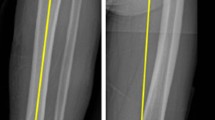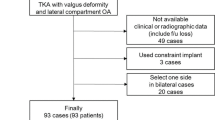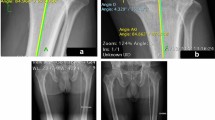Abstract
Background
Restoration of a neutral mechanical axis (MA) is important to the success of total knee arthroplasty (TKA). While known differences are present between Asians and Caucasians regarding native knee alignment, it is unknown whether such differences exist amongst Native Hawaiian/Other Pacific Islanders (NHPI) or if utilizing a fixed distal femoral cut of 6° can consistently achieve a neutral MA in these minority racial groups. This study examines the preoperative deformities presented by Asians, Caucasians, and NHPI, and the resulting knee alignment achieved following TKA when a fixed 6° distal femoral cut is targeted for all patients.
Methods
Preoperative and postoperative MA was measured from 835 Asian, 447 Caucasian, and 163 NHPI hip-to-ankle radiographs. All patients underwent TKA in which a standard distal femoral cut of 6° valgus was targeted for all patients. Data were evaluated as continuous variables and by groupings of varus (MA < − 3°), valgus (MA > 3°), and neutral (− 3° ≤ MA ≤ 3°) alignment.
Results
Preoperative deformity ranged from 38° varus to 29° valgus. The proportion of Asian and NHPI presenting with varus alignment prior to surgery was significantly greater than Caucasian patients in both males (Asians: 80.6%; Caucasians: 67.0%; NHPI: 79.0%, p = 0.001) and females (Asians: 66.1%; Caucasians: 45.7%; NHPI: 63.2%, p < 0.001). There was no difference in the proportion of patients (72–79%) achieving a neutral MA amongst all three racial groups.
Conclusion
NHPI appear to have similar preoperative deformities to Asians with both groups having significantly more varus alignment than Caucasians. Despite a wide range of preoperative deformity, application of a fixed distal femoral cut of 6° valgus successfully established a neutral MA equally in the majority of patients across all three racial groups.


Similar content being viewed by others
References
Cherian JJ, Kapadia BH, Banerjee S, Jauregui JJ, Issa K, Mont MA (2014) Mechanical, anatomical, and kinematic axis in TKA: concepts and practical applications. Curr Rev Musculoskelet Med 7:89–95. https://doi.org/10.1007/S12178-014-9218-Y
Hsu RWW, Himeno S, Coventry MB, Chao EYS (1990) Normal axial alignment of the lower extremity and load-bearing distribution at the knee. Clin Orthop Relat Res 255:215–227. https://doi.org/10.1097/00003086-199006000-00029
Hess S, Moser LB, Amsler F, Behrend H, Hirschmann MT (2019) Highly variable coronal tibial and femoral alignment in osteoarthritic knees: a systematic review. Knee Surg Sports Traumatol Arthrosc 27:1368–1377. https://doi.org/10.1007/S00167-019-05506-2
Sharma L, Song J, Felson DT, Cahue S, Shamiyeh E, Dunlop DD (2001) The role of knee alignment in disease progression and functional decline in knee osteoarthritis. JAMA 286:188–195. https://doi.org/10.1001/JAMA.286.2.188
Jeffery RS, Morris RW, Denham RA (1991) Coronal alignment after total knee replacement. J Bone Jt Surg Br 73:709–714. https://doi.org/10.1302/0301-620X.73B5.1894655
Berend ME, Ritter MA, Meding JB, Faris PM, Keating EM, Redelman R et al (2004) Tibial component failure mechanisms in total knee arthroplasty. Clin Orthop Relat Res 428:26–34. https://doi.org/10.1097/01.BLO.0000148578.22729.0E
Fang DM, Ritter MA, Davis KE (2009) Coronal alignment in total knee arthroplasty: just how important is it? J Arthroplasty 24:39–43. https://doi.org/10.1016/J.ARTH.2009.04.034
Green GV, Berend KR, Berend ME, Glisson RR, Vail TP (2002) The effects of varus tibial alignment on proximal tibial surface strain in total knee arthroplasty: The posteromedial hot spot. J Arthroplasty 17:1033–1039. https://doi.org/10.1054/ARTH.2002.35796
Werner FW, Ayers DC, Maletsky LP, Rullkoetter PJ (2005) The effect of valgus/varus malalignment on load distribution in total knee replacements. J Biomech 38:349–355. https://doi.org/10.1016/J.JBIOMECH.2004.02.024
Ritter MA, Davis KE, Meding JB, Pierson JL, Berend ME, Malinzak RA (2011) The effect of alignment and BMI on failure of total knee replacement. J Bone Jt Surg Ser A 93:1588–1596. https://doi.org/10.2106/JBJS.J.00772
Collier MB, Engh CA, McAuley JP, Engh GA (2007) Factors associated with the loss of thickness of polyethylene tibial bearings after knee arthroplasty. J Bone Jt Surg Am 89:1306–1314. https://doi.org/10.2106/JBJS.F.00667
Choong PF, Dowsey MM, Stoney JD (2009) Does accurate anatomical alignment result in better function and quality of life? Comparing conventional and computer-assisted total knee arthroplasty. J Arthroplasty 24:560–569. https://doi.org/10.1016/J.ARTH.2008.02.018
Longstaff LM, Sloan K, Stamp N, Scaddan M, Beaver R (2009) Good alignment after total knee arthroplasty leads to faster rehabilitation and better function. J Arthroplasty 24:570–578. https://doi.org/10.1016/J.ARTH.2008.03.002
Greene KA (2007) Gender-specific design in total knee arthroplasty. J Arthroplasty 22:27–31. https://doi.org/10.1016/J.ARTH.2007.05.019
Conley S, Rosenberg A, Crowninshield R (2007) The female knee: anatomic variations. J Am Acad Orthop Surg 15(Suppl):1. https://doi.org/10.5435/00124635-200700001-00009
Low FH, Khoo LP, Chua CK, Lo NN (2000) Kinematic analysis of total knee prosthesis designed for Asian population. Crit Rev Biomed Eng 28:33–40. https://doi.org/10.1615/CRITREVBIOMEDENG.V28.I12.70
Nayak M, Kumar V, Yadav R, Maredupaka S, Srivastava DN, Malhotra R et al (2020) Coronal alignment of the lower extremity: a gender-based radio-graphic analysis in Indian patients. Indian J Orthopaedics 54:504–512. https://doi.org/10.1007/s43465-020-00050-5
Nagamine R, Miura H, Bravo CV, Urabe K, Matsuda S, Miyanishi K et al (2000) Anatomic variations should be considered in total knee arthroplasty. J Orthop Sci 5:232–237. https://doi.org/10.1007/S007760050157
Hovinga KR, Lerner AL (2009) Anatomic variations between Japanese and caucasian populations in the healthy young adult knee joint. J Orthop Res 27:1191–1196. https://doi.org/10.1002/jor.20858
Loeser RF (2010) Age-related changes in the musculoskeletal system and the development of osteoarthritis. Clin Geriatr Med 26:371–386. https://doi.org/10.1016/J.CGER.2010.03.002
Howell SM, Kuznik K, Hull ML, Siston RA (2010) Longitudinal shapes of the tibia and femur are unrelated and variable. Clin Orthop Relat Res 468:1142–1148. https://doi.org/10.1007/S11999-009-0984-6
Thienpont E, Schwab PE, Cornu O, Bellemans J, Victor J (2017) Bone morphotypes of the varus and valgus knee. Arch Orthop Trauma Surg 137:393–400. https://doi.org/10.1007/S00402-017-2626-X
Yau WP, Chiu KY, Tang WM, Ng TP (2007) Coronal bowing of the femur and tibia in Chinese: its incidence and effects on total knee arthroplasty planning. J Orthop Surg (Hong Kong) 15:32–36
Lasam MPG, Lee KJ, Chang CB, Kang YG, Kim TK (2013) Femoral lateral bowing and varus condylar orientation are prevalent and affect axial alignment of TKA in Koreans knee. Clin Orthop Relat Res 471:1472–1483. https://doi.org/10.1007/s11999-012-2618-7
Moser LB, Hess S, de Villeneuve Bargemon JB, Faizan A, Liarno S, Amsler F et al (2022) Ethnical differences in knee phenotypes indicate the need for a more individualized approach in knee arthroplasty: a comparison of 80 Asian knees with 308 Caucasian knees. J Pers Med. https://doi.org/10.3390/JPM12010121
Tang WM, Zhu YH, Chiu KY (2000) Axial alignment of the lower extremity in Chinese adults. J Bone Jt Surg Am 82:1603–1608. https://doi.org/10.2106/00004623-200011000-00014
Mullaji AB, Shetty GM, Lingaraju AP, Bhayde S (2013) Which factors increase risk of malalignment of the hip-knee-ankle axis in TKA? Knee Clin Orthop Relat Res 471:134–141. https://doi.org/10.1007/S11999-012-2520-3/TABLES/5
Kim D-K, Seo M-C, Song S-J, Kim K-I (2015) Are Korean patients different from other ethnic groups in total knee arthroplasty? Knee Surg Relat Res 27:199–206. https://doi.org/10.5792/ksrr.2015.27.4.199
Bellemans J, Colyn W, Vandenneucker H, Victor J (2012) The Chitranjan Ranawat award: is neutral mechanical alignment normal for all patients? The concept of constitutional varus. Clin Orthop Relat Res 470:45–53. https://doi.org/10.1007/S11999-011-1936-5
Nakano N, Matsumoto T, Hashimura M, Takayama K, Ishida K, Araki D et al (2016) Coronal lower limb alignment in normal knees–a radiographic analysis of 797 normal knee subjects. Knee 23:209–213. https://doi.org/10.1016/J.KNEE.2015.12.004
Sebastian AS, Wilke BK, Taunton MJ, Trousdale RT (2014) Femoral bow predicts postoperative malalignment in revision total knee arthroplasty. J Arthroplasty 29:1605–1609. https://doi.org/10.1016/j.arth.2014.03.002
Shi X, Li H, Zhou Z, Shen B, Yang J, Pei F (2016) Comparison of postoperative alignment using fixed vs individual valgus correction angle in primary total knee arthroplasty with lateral bowing femur. J Arthroplasty 31:976–983. https://doi.org/10.1016/j.arth.2015.10.040
Kraus VB, Vail TP, Worrell T, McDaniel G (2005) A comparative assessment of alignment angle of the knee by radiographic and physical examination methods. Arthritis Rheum 52:1730–1735. https://doi.org/10.1002/ART.21100
Hinman RS, May RL, Crossley KM (2006) Is there an alternative to the full-leg radiograph for determining knee joint alignment in osteoarthritis? Arthritis Rheum 55:306–313. https://doi.org/10.1002/ART.21836
Stickley CD, Wages JJ, Hetzler RK, Andrews SN, Nakasone CK (2017) Standard radiographs are not sufficient for assessing knee mechanical axis in patients with advanced osteoarthritis. J Arthroplasty 32:1013–1017. https://doi.org/10.1016/J.ARTH.2016.09.024
Andrews SN, Beeler DM, Parke EA, Nakasone CK, Stickley CD (2019) Fixed distal femoral cut of 6° valgus in total knee arthroplasty: a radiographic review of 788 consecutive cases. J Arthroplasty 34:755–759. https://doi.org/10.1016/J.ARTH.2018.12.013
Brouwer GM, van Tol AW, Bergink AP, Belo JN, Bernsen RMD, Reijman M et al (2007) Association between valgus and varus alignment and the development and progression of radiographic osteoarthritis of the knee. Arthritis Rheum 56:1204–1211. https://doi.org/10.1002/ART.22515
Felson DT, Goggins J, Niu J, Zhang Y, Hunter DJ (2004) The effect of body weight on progression of knee osteoarthritis is dependent on alignment. Arthritis Rheum 50:3904–3909. https://doi.org/10.1002/ART.20726
Petersen TL, Engh GA (1988) Radiographic assessment of knee alignment after total knee arthroplasty. J Arthroplasty 3:67–72. https://doi.org/10.1016/S0883-5403(88)80054-8
Issa SN, Dunlop D, Chang A, Song J, Prasad PV, Guermazi A et al (2007) Full-limb and knee radiography assessments of varus-valgus alignment and their relationship to osteoarthritis disease features by magnetic resonance imaging. Arthritis Rheum 57:398–406. https://doi.org/10.1002/ART.22618
Deakin AH, Basanagoudar PL, Nunag P, Johnston AT, Sarungi M (2012) Natural distribution of the femoral mechanical-anatomical angle in an osteoarthritic population and its relevance to total knee arthroplasty. Knee 19:120–123. https://doi.org/10.1016/J.KNEE.2011.02.001
Nam D, Vajapey S, Haynes JA, Barrack RL, Nunley RM (2016) Does use of a variable distal femur resection angle improve radiographic alignment in primary total knee arthroplasty? J Arthroplasty 31:91–96. https://doi.org/10.1016/J.ARTH.2016.01.070
Davis JA, Hogan C, Dayton M (2015) Postoperative coronal alignment after total knee arthroplasty: does tailoring the femoral valgus cut angle really matter? J Arthroplasty 30:1444–1448. https://doi.org/10.1016/J.ARTH.2015.03.013
Shetty GM, Mullaji A, Bhayde S, Nha KW, Oh HK (2014) Factors contributing to inherent varus alignment of lower limb in normal asian adults: Role of tibial plateau inclination. Knee 21:544–548. https://doi.org/10.1016/j.knee.2013.09.008
Gibson K, Sayers SP, Minor MA (2010) Measurement of varus/valgus alignment in obese individuals with knee osteoarthritis. Arthritis Care Res (Hoboken) 62:690–696. https://doi.org/10.1002/ACR.20084
Messier SP, Pater M, Beavers DP, Legault C, Loeser RF, Hunter DJ et al (2014) Influences of alignment and obesity on knee joint loading in osteoarthritic gait. Osteoarthritis Cartilage 22:912–917. https://doi.org/10.1016/J.JOCA.2014.05.013
Henderson RC (1992) Tibia vara: a complication of adolescent obesity. J Pediatr 121:482–486. https://doi.org/10.1016/S0022-3476(05)81811-6
Shultz SP, D’Hondt E, Fink PW, Lenoir M, Hills AP (2014) The effects of pediatric obesity on dynamic joint malalignment during gait. Clin Biomech (Bristol, Avon) 29:835–838. https://doi.org/10.1016/J.CLINBIOMECH.2014.05.004
Compton J, Owens J, Otero J, Noiseux N, Brown T (2021) Extramedullary guide alignment is not affected by obesity in primary total knee arthroplasty. J Knee Surg 34:1076–1079. https://doi.org/10.1055/S-0040-1701438
Andrews S, Weldon E, Stickley C, Nakasone C (2019) Post total knee arthroplasty alignment of 347 consecutive obese patients receiving a fixed distal femoral cut of 6° valgus. J Orthop 18:113–116. https://doi.org/10.1016/J.JOR.2019.10.006
Funding
This research received no specific grant from any funding agency in the public, commercial or non-for-profit sectors.
Author information
Authors and Affiliations
Corresponding author
Ethics declarations
Conflict of interest
Author Cass Nakasone receives royalties as a design surgeon and consulting fees from Ortho Development Corporation and is a consultant for Ortho Grid Systems. Cass Nakasone has no other relevant financial or non-financial interests to disclose. All other authors certifies that he or she has no commercial associations (e.g. consultancies, stock ownership, equity interest, patent/licensing arrangements, etc.) that might pose a conflict of interest in connection with the submitted article.
Ethical approval
This retrospective chart review study involving human participants was in accordance with the ethical standards of the institutional and national research committee and with the 1964 Helsinki Declaration and its later amendments or comparable ethical standards. The Hawai’i Pacific Health Research Institute (local Western Institutional Review Board) approved this study.
Informed consent
This was a retrospective chart review and data collected were deidentified and presented as large scale, aggregate data. Therefore, no informed consent was obtained or required by the IRB.
Additional information
Publisher's Note
Springer Nature remains neutral with regard to jurisdictional claims in published maps and institutional affiliations.
Rights and permissions
Springer Nature or its licensor (e.g. a society or other partner) holds exclusive rights to this article under a publishing agreement with the author(s) or other rightsholder(s); author self-archiving of the accepted manuscript version of this article is solely governed by the terms of such publishing agreement and applicable law.
About this article
Cite this article
Abella, M., Ong, V., Thorne, T. et al. Fixed 6° distal femoral cut consistently achieves neutral alignment for Asians, Caucasians, and Native Hawaiian/Pacific Islanders. Arch Orthop Trauma Surg 143, 4371–4378 (2023). https://doi.org/10.1007/s00402-022-04673-1
Received:
Accepted:
Published:
Issue Date:
DOI: https://doi.org/10.1007/s00402-022-04673-1




